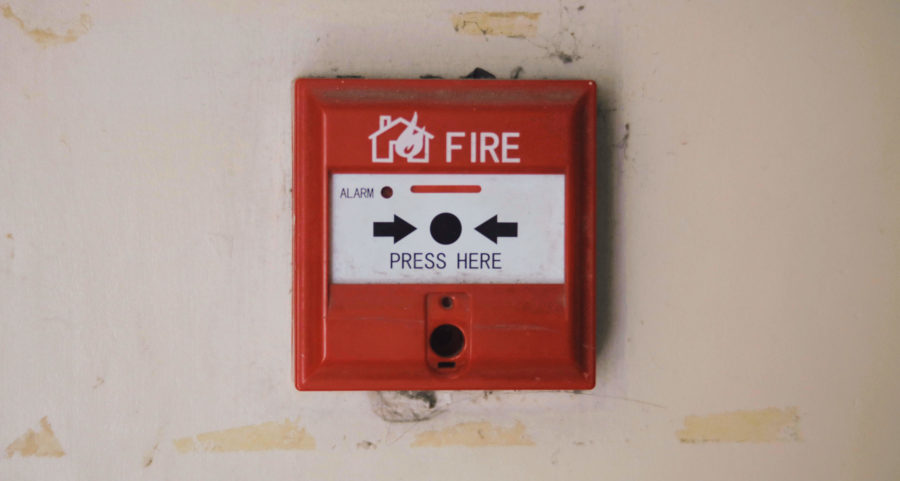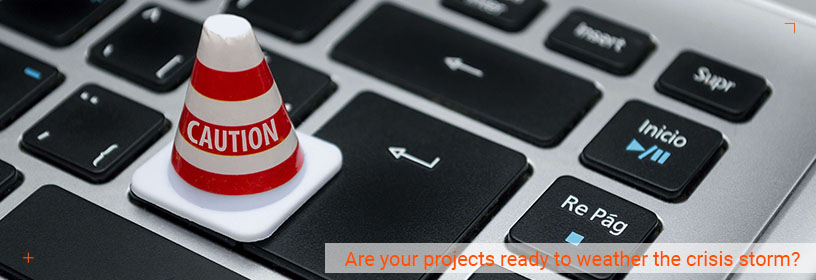If you want to identify concrete steps you can take in order to overcome this difficult period, if you want to counteract, through positive action, the crisis-associated stress and anxiety, this article is for you.
More than that, I will guide you towards a new approach that will help you deliver better medium and long-term results in your projects.
That being said, let’s get started!
Inflation. Cost-cutting. Optimization.
Any type of crisis comes with higher risks, regardless of industry and activity type. The situation is volatile and the challenges you need to address quickly and appropriately multiply. Everything you do or decide not to do will have a major impact.
However, from a change management, action taking or making decisions (you avoided until now) perspective, and also when considering innovating in a conservative environment, a crisis puts you in a „make it or break it” type situation, known as „Burning Platform”. In other words, change is necessary to be able to continue, and its benefits exceed the risks and outweigh the psychological, financial and time costs.
A Burning Platform is a metaphor used to explain the necessity of change despite the fear of the unknown consequences. This metaphor was derived from the fatal explosion of an oil drilling platform in which one survivor had to choose to jump into a sea of burning oil rather than burn on the platform.

The first steps in managing the situation are the right mindset and the ability to focus on the proverbial other side of the coin: a crisis is also an opportunity. You have to overcome the panic, accept the discomfort and focus on finding solutions. There are always solutions, that’s not the issue, the issue is to identify the best ones and implement them quickly.
It’s important to be honest and take responsibility, so let’s admit it: if things had been working perfectly when the crisis hit, its impact would have been significantly reduced. But, most likely, there were already (chronic or not) problems related to your way of working in projects for the crisis to sharpen or make obvious.
And the reason is that, unfortunately, change is always difficult. Even if its effect would be to stop the „hemorrhaging” of your project’s resources. Also, the „if it’s not (totally) broken, why fix it” standard is far more frequent than we would like to think.
More to the point:
- For companies that don’t directly generate income by delivering projects for their clients, projects are viewed as support for the operational, day-to-day activity. Consequently, there is quite a lot of tolerance for delays and cost or timing overruns. Also, the effort needed to change might seem misdirected, in the larger context of their business priorities.
- Assuming change is taken into account, the J-curve effect and people’s resistance to change would still need to be managed. In short, it might seem like a good idea to change the way of working, to improve projects, but… short-term productivity decreases, people are impatient and demotivated, so… submitting to change might not be OK after all. Somewhere along the lines of: “What we have now works” or „I understand, it sounds good / it might work in other companies, but we did everything possible and it doesn’t work in our particular case”.
- Quite often, in an ad-hoc way of working, urgent matters take priority and the most vocal people get their way. Words like „strategic” or „proactive” are powerful in theory, but don’t really apply in such an environment.
- In smaller companies, things are, in most cases, even worse: the first opportunity, the first idea that sounds good enough wins. And the lack of discipline is overpowering.
I don’t want to seem harsh. Nor do I lack empathy. Quite the contrary. I understand these situations. And it’s a valid point of view: we can’t afford medium and long-term initiatives, we just want to know how to „survive the winter” (in our case, this crisis).
But that doesn’t mean we don’t need to define a way of working that gives us the opportunity to do things better, to respond better to change, to solve internal problems related to processes, tools and/or human interactions.
A company will respond better to a crisis, regardless of its magnitude, if it did its homework. Meaning a minimal annual or strategic planning, with clearly set directions and objectives.
How to prepare for winter? It doesn’t matter anymore, winter is already here.
The problem is „storm” has already hit and the focus automatically turns from productivity and development to damage control.
The same situation as above, but with significant pressure added on top
However, still no need to despair. In any situation there are options to help us move forward and, more than that, do things better than before.
First things first: stop the bleeding!
In other words, if you have to choose, concentrate on the way you deliver your critical projects:
- Work collaboratively and use bottom-up input, even if the goals are set by the top management
- Especially now, when things tend to happen at a higher speed, give your project the gifts of clarity and the basic planning it desperately needs
- Focus on quick wins, to boost morale
- Set up a process that allows you a faster implementation, increased visibility and fast decision making
- Become more emotionally resilient. Understand that everything is more difficult now. It’s normal to make mistakes and we can always do better next time (inspect & adapt), but the high level of stress can translate into harsher replies or a more aggressive language. „Hard on problems, nice on people!” it’s a principle we should always follow, even if slip-ups are more frequent during this period.

Second: prevent the bleeding
Initiate carefully calculated cost-cutting or optimization projects:
a. Cost-cutting / optimization projects
Are already present on most agendas. Tread carefully. Many professionals have already been through this scenario for a couple of times before and their past experiences of poorly managed situations have most likely left a bitter taste.
A healthy way of doing things would involve checking each step of the process and making decisions based on cost and value.
Damage control version: instead of cutting because you have to, you try an optimization or, in the worst-case scenario, you focus on the areas that would be impacted the least by your cost-cutting. In technical terms: an analysis project with process review (maybe some fixing), Pareto analysis, activity-based costing and maybe some process changes. Even if you just do the first ones mentioned, you already are on the right track.
b. Reducing the total duration of the process or the response time (depending on the situation)
Everybody is interested in Agile or is already doing Agile, at least in theory, but complicated and super-bureaucratic processes are still in place, because that’s how things were done initially and they are being kept the same out of inertia.
In this case, the approach is similar to the cost reduction initiative, but the focus is on optimizing the duration of each step or the durations of the steps that matter the most and for which intervention is easier. Indirectly, by optimizing the duration, we also optimize costs. Plus, we will have happier colleagues and customers.
Although not necessarily related to processes, adopting an agile or hybrid way of working in the interactions with our customers can bring many benefits. The value becomes visible earlier, people have the opportunity to provide feedback and input during the process, interaction is smoother and, especially in periods of crisis, an agile way of working can make the difference when the clients choose the partner they want to keep for further projects.
c. Improving quality or reducing defects
It sounds industrial, but it actually refers to all kinds of situations like: an IT system was implemented 5 years ago, something didn’t work form the start and still doesn’t, so we found a workaround and that’s the standard in place, although everyone is aware of the problem.
Addressing process defects generates optimizations, the people who are caught in the respective workarounds can be relieved of their unnecessary and repetitive work and switch to tasks that bring added value.
Lowers frustration, people feel the change is meaningful and helpful, and the process optimizations (or rather fixings) generate $ in the long run.
It’s a good moment to clean house, especially since it’s necessary and to our own benefit.
By the way, let’s not forget the so called „historical” processes, undocumented or last updated more than 5 years ago. What isn’t documented can’t be measured (as it should). And what can’t be measured, can’t be optimized, can it?
Sounds great, but it’s not for me
Now, I’m definitely expecting reactions like: it all sounds good, it seems logical, but these things are for big companies, not for us.
In some cases, it might be true. And I fully agree that if something doesn’t bring value and doesn’t help, it shouldn’t be done. However, there are also initiatives that are valid at any level and at any time, especially in crisis situations:
- Generating new customers and constant income, to avoid cashflow problems. Sales processes, lead generation, marketing, branding, skills development – whatever mix you use to generate customers and constant cashflow, step on it.
- Delivering quality to existing customers to generate further requests and possibly recommendations.
- And if your field of activity is directly impacted by crisis, being creative enough to innovate and find new ways of serving your clients.
Any initiative designed to improve, transform, simplify, change or create a new process turns into a project that needs to be implemented. And projects must be done smartly, as agile as possible, to „harvest” results medium and long term and, perhaps most importantly, to generate quick wins. Because when in crisis… everything needs to happen yesterday and patience is short.
Also, the two main ideas explored in this article, abandoning the „this is how we’ve always done it” standard and the optimization of costs, are perfectly applicable to projects as well.

Many projects are mishandled. A lot of energy and money are wasted fire-fighting on a daily basis. There is a high cost of friction generated by lack of communication and transparency. By the time results start to be delivered, there’s no one left who is willing to get involved in any initiative.
In these cases, to accelerate results I recommend a 4-step framework I use in my own projects and also teach to my students. It’s an approach any company can implement, if their projects really matter.
STEP 1 – CURRENT SITUATION ANALYSIS
STEP 2 – PROJECT MANAGEMENT TRAINING
STEP 3 – POWER PLANNING SESSION
STEP 4 – PERIODIC PROJECT REVIEW SESSIONS
More information about the 4-step framework and how this program can help your projects is available here:
Food for thought
To sum up: although building competences and transitioning from an ad-hoc way of working to structured Project Management yield the best results, we don’t have time to do this now. Or, at least, not in a standard timeline.
We need results and we need them fast! Having a magic wand would be perfection.
These initiatives are implemented as projects and, because in my career I’ve been involved in many of them, I can tell you that:
- For the optimization projects, the magic wand is a team communicating transparently and generating initiatives in line with the project examples above.
- To improve your way of working in projects, the role of the magic wand will be played by a Project Coach or a Senior PM, supported by a Project Sponsor. It’s his job to guide the adaptation process to the new way of working (so that the team members can stay focused on their tasks), and to offer help and support when needed.
And last but not least, keep in mind:
Most of the time, the cost of non-involvement or lack of action ends up being as high as the cost of change.


0 Comentarii